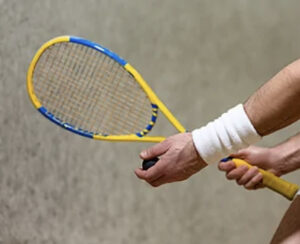When it comes to playing Squash, one of the most important techniques to master is the forehand, just like the backhand you may need to perform this move in a decisive moment of a Squash match in winning a set.

As we all know, Squash is a fast-paced sport with a lot of gameplay strategy; hence you and your opponent will constantly be moving around the court, trying to anticipate each other’s next shot.
With the Squash forehand technique, it entails you using various arm muscle groups, most notably shoulders, upper arm, and forearm.
A good forehand technique requires multiple aspects such as balance and positioning, the grip of a Squash racket, and most importantly the swing path.
That being said, there are also times in a game when you need to be able to hit the ball with your forehand from anywhere on the court – note, the forehand is very common with Squash’s racquet cousin’s badminton and tennis.
Focus on the basics
However, if you’re not comfortable with your forehand technique, the most popular to improve it is hitting against a Squash ball wall or any other large surface—it’s easy to do and can help you improve your technique.
Grip
The grip is important. The racquet should be held firmly, but not too tightly, in the hand.
On one side, you have the handle of your racquet with a string running down it that connects to a series of strings across your palm and fingers.

On the other side, you have some kind of small handle or knob that allows you to hold onto it while hitting a shot (exactly what this knob is called will vary depending on which brand/model of racquet you’re using). You’ll want to place these two pieces together in such a way that they look like one continuous piece when viewed from above.
Read our blog: Tips on How to grip a Squash racquet
Stance
The stance is the position of your feet and legs as you prepare to hit the ball. To get into a proper Squash stance, stand with your feet parallel to the side wall and shoulder-width apart.
Place your shoulders in line with the front wall, relaxed and down. Then finally, rotate your shoulders slightly towards the right so that they’re square with each other.
Take for example karate, movement, balance, and range are crucial parts of sparring and training in martial arts. These things are all tied into stance. Without the correct stance, you cannot move correctly, position yourself for strikes, or use your range most effectively.
The same fundamentals apply when it comes to Squash.
Start position
Start by standing in a relaxed position with your feet shoulder-width apart. Keep your knees slightly bent, and keep the grip at the centre of the racquet head. Your elbow should be close to your body and your racquet should be at shoulder height.
Backswing
The backswing is the initial movement of the racquet before contact. It can be divided into four parts:
- Racket head position (or “topspin”)
- Arm positioning
- Body/leg action
- The actual swing itself
The low forward swing

When it comes to the low forward swing is the same as the high forward swing, except it’s done with the racket held lower to your side.
This can be difficult for beginners, however, the same applies if you played Badminton or Tennis; however if you are a Squash novice, there is often a tendency to drop your elbow and wrist while doing a forehand shot.
In order, to do this properly, you should keep your arm straight throughout the shot and let gravity help you. Remember practice will help become better.
The most common mistake people make when attempting this shot is swinging down and back before swinging forward and up – so try not to let that happen!
Contact and follow-through
With the contact and follow, in the forehand techniques you must remember these fundamentals when it comes to contact and follow through:
- Keep your eyes on the ball
- Try to keep your head still. (This is very hard, but it’s worth practising as much as you can.)
- Keep your arm straight.
- Follow through
Watch this video of forehand shots in a rally:
Practice in the off-season or training to become a master
With the forehand, it is an extremely technical shot.
It’s important that you focus on the basics when learning this shot. The forehand is one of the most technical shots in Squash, and it can be used to open up an opponent’s position or set up a kill shot.
Once you can develop your Squash forehand in two ways: by practising the basics and by playing against a good opponent.
The latter will force you to make mistakes, which you can learn from and avoid next time around. If you stick with those two things, in time you’ll soon have a wicked forehand that’s more than capable of punishing any opponent!

